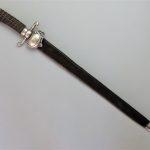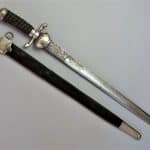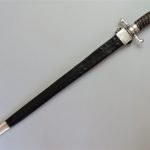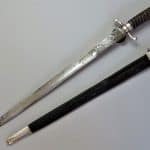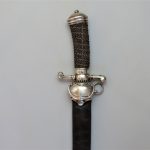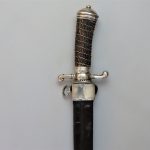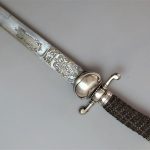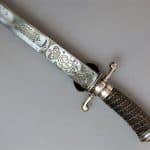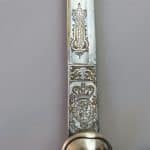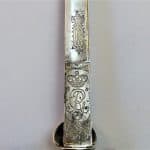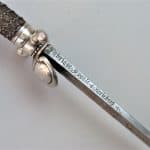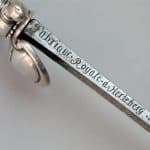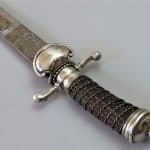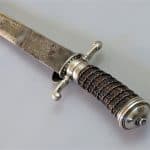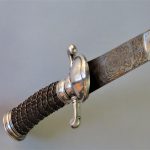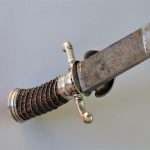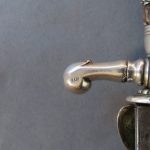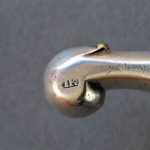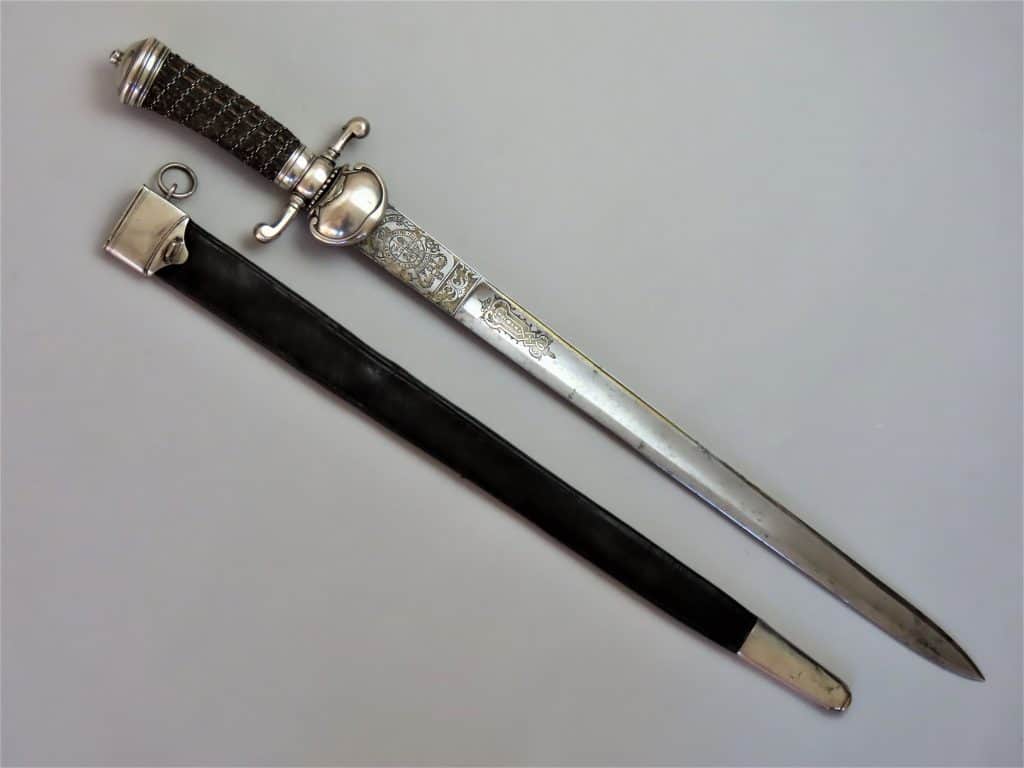
A Fine Hanoverian Georgian Officer’s Side Arm with Paktong Mounts – Second Half of the 18th Century
To enquire about this itemplease click here
Price: £2,500
Ref: 086.23
Item Description
A fine Georgian Officer’s Side Arm, engraved on its blade with the crowned British Royal Arms, crowned GR cypher, and on the spine with “Fabrique Royale a Hertzberg”, all highlighted in rich gilt. Hertzberg is a town in Lower Saxony and part of the state of Hanover. The weapon is of heavy construction and was made in Hertzberg as a military side arm for an officer serving the House of Hanover in a regiment recruited to serve British interests in the second half of the 18th century.
Swords dating to the 18th century with blades of this size are often referred to under a general ill-defined umbrella as “Hunting Swords”, and the curved bladed versions “Hunting Hangers”. The term “Hunting” attached to these smaller proportioned swords, compared to the usual full length types, is something of a misnomer. These weapons were primarily intended for offence, or defence, with regard to people, not animals. Some made in the UK were most certainly intended for military use. In his portrait Vice-Admiral John Benbow, who died in 1702, wears armour in a naval scene and is holding a robust early hanger of later cutlass proportions, and clearly intended for use in close quarter melee when ships were boarded in naval warfare.
During the 18th century a number of German states hired out their troops in commercial enterprises to fight for the armies of vying nations at war in Europe. One of these states, which was part of the Holy Roman Empire, was Hanover. Its Elector, George, became King George I of England In 1714, after which he ruled the Kingdom of Great Britain and Ireland and the Electorate of Hanover.
Hanover was one of the states that raised troops for foreign service and as a result, Britain inherited with its new king, established diplomatic routes through which German troops could be recruited into British service. For instance, the Seven Years War in Europe, from 1756 to 1763, started with George II as king and ended with George III. When Britain’s need for foreign assistance was at its highest at the outset of the American Revolutionary War, treaties were signed with these German states and around 40,000 German troops were recruited into British service at this time.
Although generally grouped as “Hessian”, these troops were recruited from a wide range of different states including: Hesse-Kassel, Hesse-Hanau, Brunswick-Wolfenbuttel, Ansbach-Bayreuth, Waldeck, Anhaldt-Zerbst and of course Hanover. The troops were recruited mainly as fully organised units or regiments rather than as individual recruits to be absorbed into the British military. Clearly there was a loyalty from the troops recruited in Hanover to their paymaster King George III who was also their own ruler. So it is no surprise to find evidence of this on their weaponry which was probably also well represented on other regimental regalia, colours, etc, although little has survived. Interestingly, Herzberg was an established town 56 miles (90 km) from the state capital of Hanover. Its industries included the production of armaments for the Hanover forces.
Other than as indicated by the quality of the blade and its gilt highlighted decoration, the prestige of this weapon is further enhanced by the mounts which are made of Paktong (Chinese Silver). More of this attractive metal was imported into France and Germany from China compared to England at the time. It seems clear therefore that the side arm was most likely made in Hertzberg for an officer in an infantry regiment recruited in Hanover for service with the British Army in the American Revolutionary War period. The British royal arms on the blade in style date to before 1803.
The sword consists of a sturdy cross-guard with counter-facing flattened swollen terminals, one of which is stamped with the maker’s mark “I K”, and a downward facing shell guard with a moulded border. The grip is of natural stag horn, spirally bound with chain, with a ribbed ferrule at the base, and a ribbed domed cap on top with an integral button. The military style leather scabbard is stitched down one side and retains its chape and mouthpiece.
The thick, heavy blade is exquisitely forged with a single deep fuller extending just underneath the back edge for three quarters of its length after which it is double edged. A second, broader, shallower fuller extends between the first fuller and the cutting edge to the tip. It has a short ricasso, after which a panel on one side is engraved with the crowned Royal Arms and the crowned GR cypher on the reverse side. These features are enhanced with strapwork and acanthus, all highlighted in rich gilt.
The overall length is 25.75 inches (65.5 cm). The blade length is 19.75 inches (just over 50 cm).
